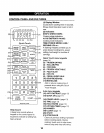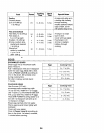
COOKING TECHNIQUES
Advantages of microwave cooking are
speed and efficiency. For warming,
heating, and defrosting, nothing
compares. There are a few tips that
will make microwaving easier and
more enjoyable.
Microwave Cooking Principles
Because microwave cooking requires
only one-quarter to one-third the time
of conventional cooking, the same
cooking principles become even more
important.
Quantity
The more food being cooked, the
longer you will have to cook it. As a
general rule, when doubling a recipe,
increase the cooking time by about 50
percent. When cutting a recipe in half,
reduce the time by about 40 percent.
Density
Dense foods, such as potatoes, roasts
and carrots, absorb microwave energy
less quickly than porous foods such as
ground beef or mashed potatoes.
Therefore, denser foods take longer to
cook.
Shape and Size
Small pieces cook faster than large
ones. For even cooking, it is important
to have all the pieces the same size.
Evenly shaped pieces, round or
doughnut shaped, microwave best.
When cooking items of varying
thickness, arrange the thick portion
near th e outer edge of the dish.
Moisture, Sugar and Fat
Food high in moisture, sugar or fat
cook faster than foods that are low in
these substances. Add a minimum of
liquid to moist foods. An excess
amount of water slows cooking.
Starting Temperature
Frozen or refrigerated foods take
longer to microwave than food at room
tempejature.
Delicate Ingredients
Some foods require special attention
when cooked in the microwave oven.
Delicate foods such as eggs, cheese,
mayonnaise, etc. cook so quickly, they
should be watched carefully.
Microwave Cooking Techniques
Arranging: Arrange foods in a circular
pattern, when possible.
Piercing: Pierce the membrane of
foods such as eggs, oysters, snails,
sausages, livers, clams and whole
vegetables, so they do not burst.
Covering: Covering speeds heating
and prevents spattering.
Stirring: To help food cook more
quickly and evenly.
Turning Over: To help larger foods
such as roasts or whole chickens cook
more evenly.
Reheating: Place food that is
denser/larger/thicker to the outer
edge and the smaller/thinner or more
porous food to the center.
Shielding: To prevent overcooking,
thin or bony areas can be protected
with small strips of aluminum foil.
Standing Time: Foods continue
cooking even after removal from the
oven. Standing time is necessary to
allow foods to complete cooking.
Converting Recipes
Microwave recipes will likely call for
less liquid and cooking time.
Safety Food Temperatures
For your safety, following temperature
is recommended to avoid potential
food poisoning problems.
160°F (71 °C): Meat, Fish, Eggs
165°F (74°C): Reheating foods
170°F (77°C): Poultry (White Meat)
180°F (82°(;): Poultry (Dark Meat)
18


















